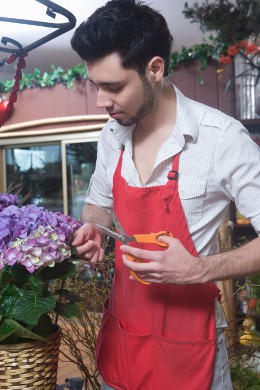Pruning hydrangeas at the appropriate time is necessary for better growth and timely flowering. This article highlights the basic tips on how to prune these plants.

Hydrangeas are a group of flowering plants with over 70 varied species. Most of the varieties are shrubs and bushes. Nevertheless, they can grow to be a small tree or a climbing liana. Flowers are developed in early spring and continue until the end of autumn. Based on the species, the blooms are white, pink, red, blue, and purple. The large, vibrant-colored, round-shaped flower heads make them a popular plant for flower gardens.
Hydrangea plants are deciduous and develop new foliage as soon as spring arrives. They are best grown in full sunlight to partially-shaded areas that have moist and well-drained soil. In case you do not have a garden area that meets these growth requirements, you can always grow them in pots and containers with a suitable potting mixture. This way, you can transfer the plants in sunlit areas for better growth and flowering. Another important factor is pruning the plants at the right time with correct garden tools.
Similar to any other shrub species, pruning is important for maintenance of healthy hydrangeas. Even though they are hardy plants, at times they do not flower in the blooming season. This lack of flowers can be attributed to a lack of adequate sunlight and exposure to cold conditions for a prolonged period. Another probable cause for the absence of flower development is pruning the bushes at the wrong time.
Use the Right Equipment
Using the correct garden tools for pruning is as important as selecting the right time. Sharp, appropriately-sized shears will minimize damage to the plants. However, to prune a hydrangea tree, you may require renting motor-operated pruning devices to get to the top parts of the tree.
Check the Time
Pruning times may vary depending upon the cultivar in your garden. For example, bigleaf hydrangeas are most susceptible to frost. So, you can prune these varieties during the summer, as soon as the flowers start fading. The oakleaf and peegee hydrangea grow best with late winter or early spring pruning.
Remove the Dead Branches
Remove the dead branches (if any) and old stems from the lower portion first. Prune them down to a level near the main stem. In case you notice the development of disease on the leaves, make sure you trim those leaves and discard them. Also, do not forget to remove last season flower heads. By doing so, you are reserving the nutrients for new development of shoots and flowers in the coming season.
Clean the Trimmed Branches
After pruning is over, collect and discard the trimmed branches. This will prevent spreading of diseases and further infestation of pests. You can rake the soil surrounding the plants. Apply a thick layer of mulch over the soil in order to prevent weed growth and evaporation of moisture.
If you have climbing hydrangeas, you can trim them at any time of the year. For most of the varieties, spring and fall is the ideal pruning time. Pruning will encourage healthy growth of these flowering plants. Gardening specialists believe that pruning correctly improves the plant vigor and helps increase the flower size.






 Hydrangeas are a group of flowering plants with over 70 varied species. Most of the varieties are shrubs and bushes. Nevertheless, they can grow to be a small tree or a climbing liana. Flowers are developed in early spring and continue until the end of autumn. Based on the species, the blooms are white, pink, red, blue, and purple. The large, vibrant-colored, round-shaped flower heads make them a popular plant for flower gardens.
Hydrangeas are a group of flowering plants with over 70 varied species. Most of the varieties are shrubs and bushes. Nevertheless, they can grow to be a small tree or a climbing liana. Flowers are developed in early spring and continue until the end of autumn. Based on the species, the blooms are white, pink, red, blue, and purple. The large, vibrant-colored, round-shaped flower heads make them a popular plant for flower gardens.